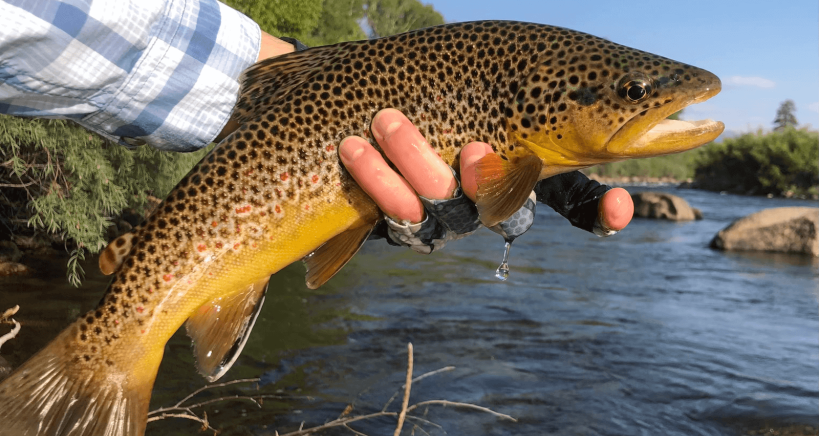The Arkansas River is a brown trout fishery. This statement, though historically true, has become less so in recent years. The introduction of the Hofer-Colorado River rainbow cross has seen the population pattern diversify, with about 25% of the fish now rainbows against a 75% majority of browns. At times of the year or day when water temperatures are quite cold, browns will lay dormant and rainbows will seem to be the predominant fish. Also, well-aerated deep green pools will often hold suspended rainbows where browns are rarely found. Still, the majority of the fish are browns and a strategy that accounts for their essential behavior is warranted at most times of the year.
Brown trout do not thrive in high velocity current. When one looks at the gradient of the Arkansas between Leadville and Canon City, this issue is bound to arise. Closer examination, however, also reveals that the fast current velocity tends to carry away a lot of the smaller sediments and gravel, depositing them into bar formations in areas of lesser gradient, and leaving behind a jumbled riverbed of multi-sized rocks and boulders. It is this tremendous variety in rock size that creates micro-habitats, velocity shelters, for brown trout throughout the river corridor. When working the Arkansas, sight fishing to feeding fish is relatively rare. Rather, one reads the structure of the river bed and, particularly, the shoreline, fishing that structure to locate the browns.
Brown trout on the Arkansas are wild fish. They reproduce naturally and retain the characteristics traditionally associated with their species – an innate wariness of human beings, a predilection for structure coupled with an aversion to fast current, and a strong predatory instinct most often manifested by ambush behavior. The following tips will help in fishing to brown trout:
- Keep a low profile. If an Arkansas River brown trout sees you it will normally move into deeper water and quit feeding. Approach the river from the fish’s perspective, remembering that they generally are facing upstream (so approach good water from below) and are often situated in the pocket water along the shoreline. Wear muted colors.
- Cast to the most vulnerable fish first. Browns spook easily – the more exposed they feel the less pressure they will tolerate. Shallow water or the pockets along the edges should be drifted before the more obvious seams and shelf lines. We often say that people are standing where they should fish and fishing where they should stand. One can divide the fishable area of the river into a series of parallel drifts; start with the ones holding the most exposed fish and move out from there. Several drifts in each lane is usually sufficient – browns will generally bite or they won’t but casting to a certain fish for half an hour will not normally change its mind.
- Give yourself room to move. With the previous paragraph in mind, don’t simply pick a spot that looks like it should have fish and stay with it all day. This is not a tailwater and the brown trout are unaccustomed to pressure. Several drifts in each lane is sufficient. Then take a few steps upstream and repeat the process. Cover the water. Then keep moving.
- The right presentation is more important than the right fly. Even when Arkansas River browns seemed completely keyed in on a blue wing olive mayfly hatch, they may well rise and eat a large Royal Wulff if it has a good natural drift. Brown trout are opportunists. If something doesn’t frighten them or make them suspicious, they will often eat it. By the same token, if they are not keyed onto a particular bug, one can prey on their predatory instincts, twitching a large hopper in shallow water or stripping a flashy streamer through shoreline pockets. In these cases, energizing the fly, giving it some irresistible action, will induce fish to strike when they might otherwise be skeptical.
Stop by one of our two locations for more details regarding Arkansas River brown trout and what’s happening on the water at the moment. We will do our best to ensure you have the best possible day out on the water.


